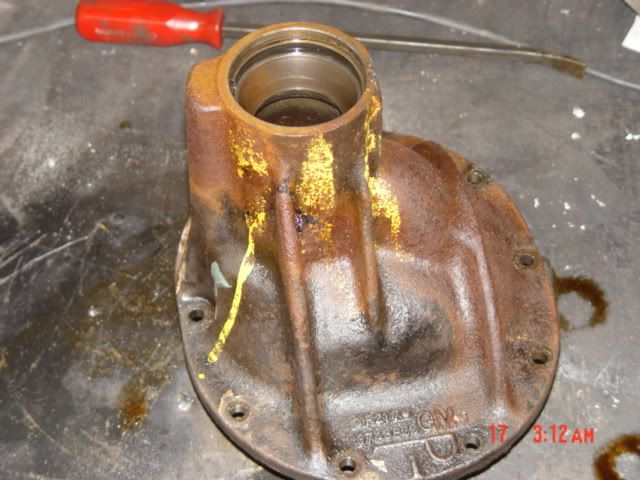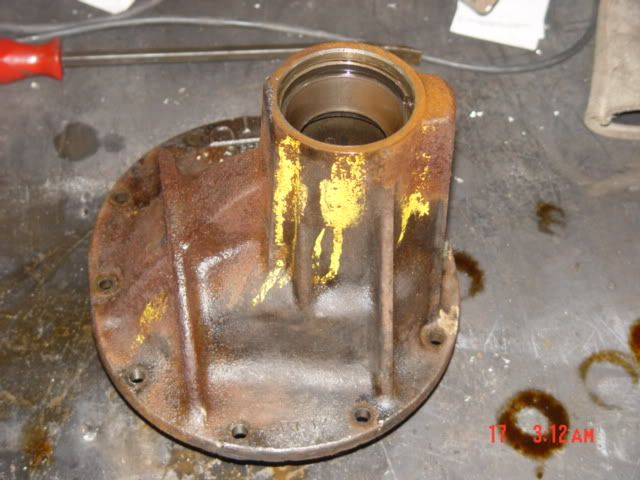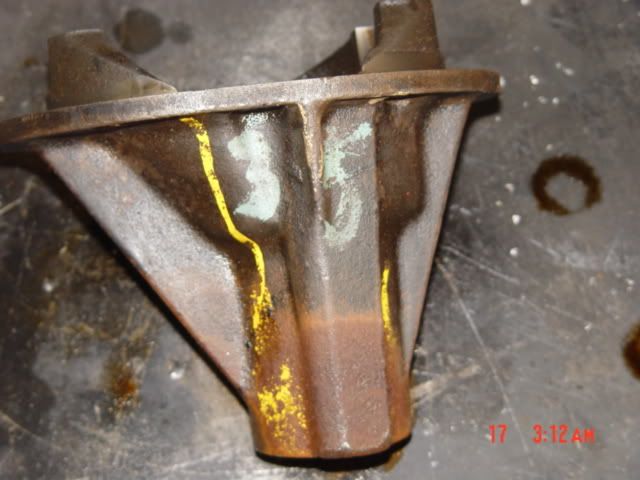I ask a related question earlier, with pictures, and so far thare have not been any positive, difinitive answers.
So, here is a follow-on question for that same rearend.
After thorough cleaning of the Oct cast rearend center case (but no blasting), it APPEARS that the rearend center case was painted black FIRST. Then, maybe after the machining operations and/or assembly, the paint markings (yellow/blue) were applied. Clearly they were applied sloppily with a brush that was probably dipped into a nearby paint can.
After the rearend center section was completely finished, it was then installed into an axle housing. Next, the axles and brakes were installed into the housing and the completed axle housing was shipped (in bulk or batches) from the Detroit axle plant to St. Louis WITH PAINT MARKINGS showing. Once the complete axle housing was installed on the frame, along with other chassis components (including front cross member/suspension assembly?????????), then the entire assembled chassis was painted with chassis black, thus covering up any (or most) paint markings that were applied BEFORE various components were installed onto the frame. Based on Judging manuals, "expert" NCRS opinions, Ken Kayser's latest book as well as Noland's book/pictures, this appears to be how it was done.
Now, here is the question.
Is this a correct as to how the chassis painting processes occured on the early cars (56-62) at St. Louis?
I'm attempting to get the correct (as much as is possible) finish on the below rearend.
Again, UNQUESTIONABLY, the yellow and blue paint markings are factory applied-----------------------AND, they are applied on top of a black base coat, but yet none of these paint markings seem to appear on FINISHED cars.
No one could provide difinitive answers regarding the purpose of the yellow/blue markings, so how about the final paint finish?????




So, here is a follow-on question for that same rearend.
After thorough cleaning of the Oct cast rearend center case (but no blasting), it APPEARS that the rearend center case was painted black FIRST. Then, maybe after the machining operations and/or assembly, the paint markings (yellow/blue) were applied. Clearly they were applied sloppily with a brush that was probably dipped into a nearby paint can.
After the rearend center section was completely finished, it was then installed into an axle housing. Next, the axles and brakes were installed into the housing and the completed axle housing was shipped (in bulk or batches) from the Detroit axle plant to St. Louis WITH PAINT MARKINGS showing. Once the complete axle housing was installed on the frame, along with other chassis components (including front cross member/suspension assembly?????????), then the entire assembled chassis was painted with chassis black, thus covering up any (or most) paint markings that were applied BEFORE various components were installed onto the frame. Based on Judging manuals, "expert" NCRS opinions, Ken Kayser's latest book as well as Noland's book/pictures, this appears to be how it was done.
Now, here is the question.
Is this a correct as to how the chassis painting processes occured on the early cars (56-62) at St. Louis?
I'm attempting to get the correct (as much as is possible) finish on the below rearend.
Again, UNQUESTIONABLY, the yellow and blue paint markings are factory applied-----------------------AND, they are applied on top of a black base coat, but yet none of these paint markings seem to appear on FINISHED cars.
No one could provide difinitive answers regarding the purpose of the yellow/blue markings, so how about the final paint finish?????




 Wasn't a coat of oil tar paint added after the frame was finished to protect against rust with paint markings covered? My 57 was!
Wasn't a coat of oil tar paint added after the frame was finished to protect against rust with paint markings covered? My 57 was!


 Money rules
Money rules







Comment